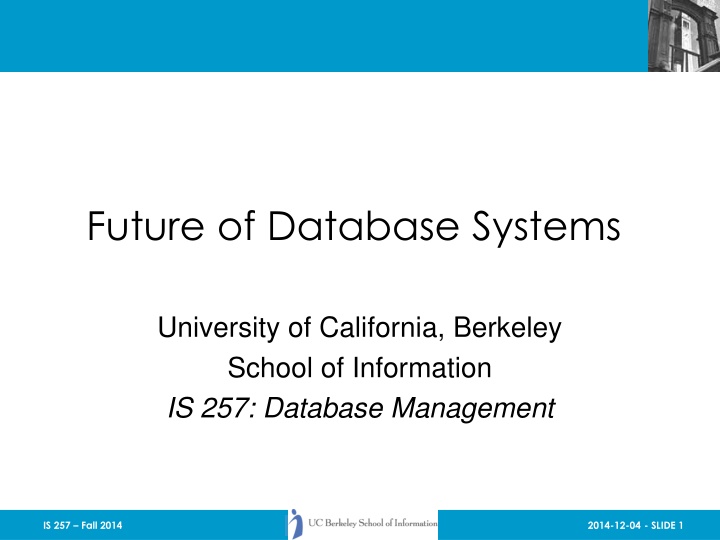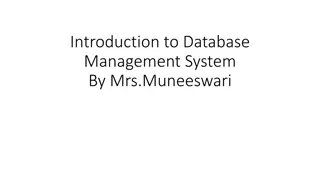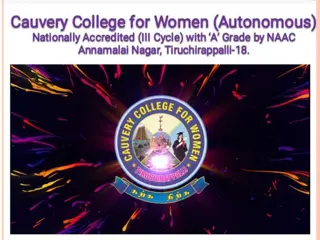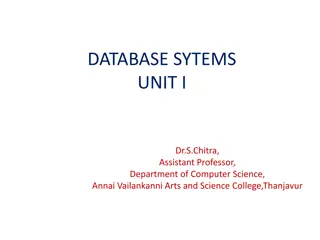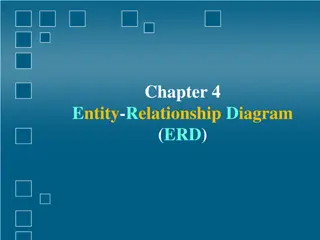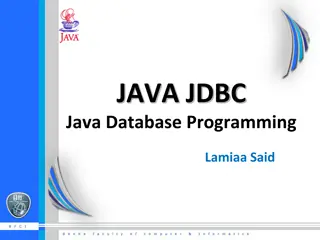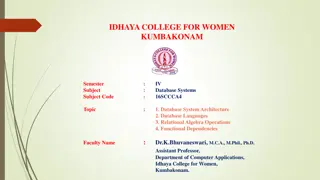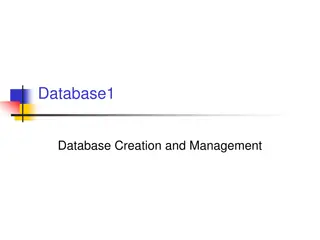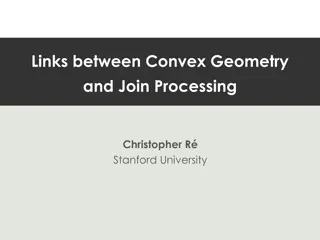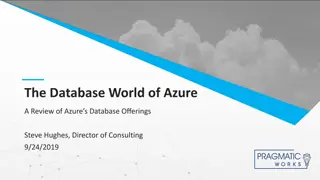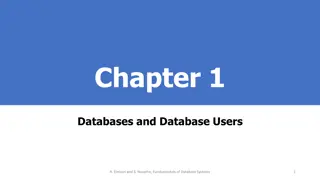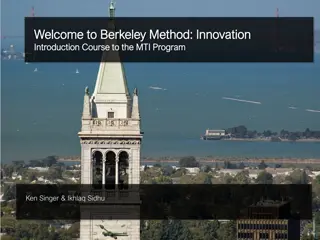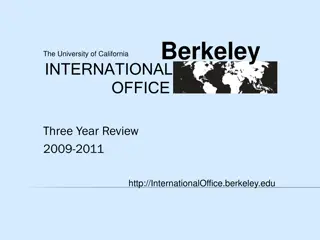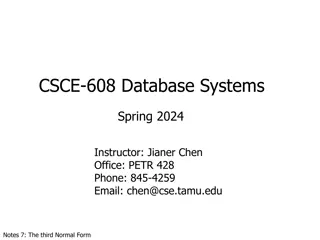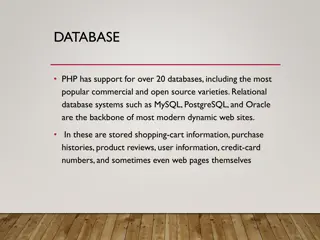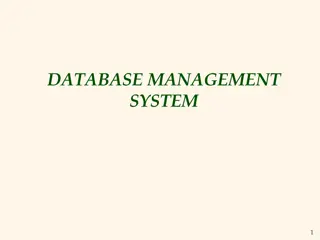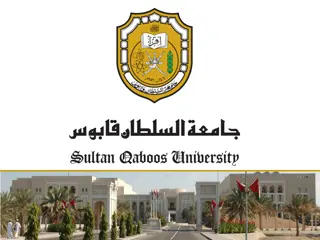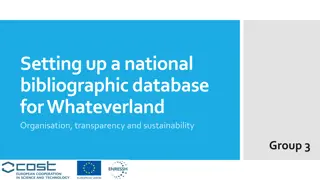Future of Database Systems at UC Berkeley: Predicting the Evolution
The forward-thinking insights on database systems from UC Berkeley's School of Information, discussing past accomplishments and future projections. Delve into historical quotes underestimating technological advancements, highlighting the evolving landscape of information management. Witness how perceptions have shifted over time, envisioning the potential transformations awaiting database systems in the upcoming years.
Download Presentation

Please find below an Image/Link to download the presentation.
The content on the website is provided AS IS for your information and personal use only. It may not be sold, licensed, or shared on other websites without obtaining consent from the author.If you encounter any issues during the download, it is possible that the publisher has removed the file from their server.
You are allowed to download the files provided on this website for personal or commercial use, subject to the condition that they are used lawfully. All files are the property of their respective owners.
The content on the website is provided AS IS for your information and personal use only. It may not be sold, licensed, or shared on other websites without obtaining consent from the author.
E N D
Presentation Transcript
Future of Database Systems University of California, Berkeley School of Information IS 257: Database Management IS 257 Fall 2014 2014-12-04 - SLIDE 1
Lecture Outline Future of Database Systems Predicting the future Quotes from Leon Kappelman The future is ours CACM, March 2001 Accomplishments of database research over the past 30 years Next-Generation Databases and the Future IS 257 Fall 2014 2014-12-04 - SLIDE 2
Radio has no future, Heavier-than-air flying machines are impossible. X-rays will prove to be a hoax. William Thompson (Lord Kelvin), 1899 IS 257 Fall 2014 2014-12-04 - SLIDE 3
This Telephone has too many shortcomings to be seriously considered as a means of communication. The device is inherently of no value to us. Western Union, Internal Memo, 1876 IS 257 Fall 2014 2014-12-04 - SLIDE 4
I think there is a world market for maybe five computers Thomas Watson, Chair of IBM, 1943 IS 257 Fall 2014 2014-12-04 - SLIDE 5
The problem with television is that the people must sit and keep their eyes glued on the screen; the average American family hasn t time for it. New York Times, 1949 IS 257 Fall 2014 2014-12-04 - SLIDE 6
Where the ENIAC is equipped with 18,000 vacuum tubes and weighs 30 tons, computers in the future may have only 1000 vacuum tubes and weigh only 1.5 tons Popular Mechanics, 1949 IS 257 Fall 2014 2014-12-04 - SLIDE 7
There is no reason anyone would want a computer in their home. Ken Olson, president and chair of Digital Equipment Corp., 1977. IS 257 Fall 2014 2014-12-04 - SLIDE 8
640K ought to be enough for anybody. Attributed to Bill Gates, 1981 IS 257 Fall 2014 2014-12-04 - SLIDE 9
By the turn of this century, we will live in a paperless society. Roger Smith, Chair of GM, 1986 IS 257 Fall 2014 2014-12-04 - SLIDE 10
I predict the internet will go spectacularly supernova and in 1996 catastrophically collapse. Bob Metcalfe (3-Com founder and inventor of ethernet), 1995 IS 257 Fall 2014 2014-12-04 - SLIDE 11
Lecture Outline Review Object-Oriented Database Development Future of Database Systems Predicting the future Quotes from Leon Kappelman The future is ours CACM, March 2001 Accomplishments of database research over the past 30 years Next-Generation Databases and the Future IS 257 Fall 2014 2014-12-04 - SLIDE 12
Database Research Database research community less than 40 years old Has been concerned with business type applications that have the following demands: Efficiency in access and modification of very large amounts of data Resilience in surviving hardware and software errors without losing data Access control to support simultaneous access by multiple users and ensure consistency Persistence of the data over long time periods regardless of the programs that access the data Research has centered on methods for designing systems with efficiency, resilience, access control, and persistence and on the languages and conceptual tools to help users to access, manipulate and design databases. IS 257 Fall 2014 2014-12-04 - SLIDE 13
Accomplishments of DBMS Research DBMS are now used in almost every computing environment to create, organize and maintain large collections of information, and this is largely due to the results of the DBMS research community s efforts, in particular: Relational DBMS Transaction management Distributed DBMS IS 257 Fall 2014 2014-12-04 - SLIDE 14
Relational DBMS The relational data model proposed by E.F. Codd in papers (1970-1972) was a breakthrough for simplicity in the conceptual model of DBMS. However, it took much research to actually turn RDBMS into realities. IS 257 Fall 2014 2014-12-04 - SLIDE 15
Relational DBMS During the 1970 s database researchers: Invented high-level relational query languages to ease the use of the DBMS for end users and applications programmers. Developed Theory and algorithms needed to optimize queries into execution plans as efficient and sophisticated as a programmer might have custom designed for an earlier DBMS IS 257 Fall 2014 2014-12-04 - SLIDE 16
Relational DBMS Developed Normalization theory to help with database design by eliminating redundancy Developed clustering algorithms to improve retrieval efficiency. Developed buffer management algorithms to exploit knowledge of access patterns Constructed indexing methods for fast access to single records or sets of records by values Implemented prototype RDBMS that formed the core of many current commercial RDBMS IS 257 Fall 2014 2014-12-04 - SLIDE 17
Relational DBMS The result of this DBMS research was the development of commercial RDBMS in the 1980 s When Codd first proposed RDBMS it was considered theoretically elegant, but it was assumed only toy RDBMS could ever be implemented due to the problems and complexities involved. Research changed that. IS 257 Fall 2014 2014-12-04 - SLIDE 18
Transaction Management Research on transaction management has dealt with the basic problems of maintaining consistency in multi-user high transaction database systems IS 257 Fall 2014 2014-12-04 - SLIDE 19
Transaction Management To guarantee that a transaction transforms the database from one consistent state to another requires: The concurrent execution of transactions must be such that they appear to execute in isolation. System failures must not result in inconsistent database states. Recovery is the technique used to provide this. IS 257 Fall 2014 2014-12-04 - SLIDE 20
Distributed Databases The ability to have a single logical database reside in two or more locations on different computers, yet to keep querying, updates and transactions all working as if it were a single database on a single machine How do you manage such a system? It has to become part of the DBMS itself, not left to the application layer IS 257 Fall 2014 2014-12-04 - SLIDE 21
Lecture Outline Review Object-Oriented Database Development Future of Database Systems Predicting the future Quotes from Leon Kappelman The future is ours CACM, March 2001 Accomplishments of database research over the past 30 years Next-Generation Databases and the Future IS 257 Fall 2014 2014-12-04 - SLIDE 22
Next Generation Database Systems Where are we going from here? Hardware is getting faster and cheaper DBMS technology continues to improve and change OODBMS ORDBMS NoSQL NewSQL Bigger challenges for DBMS technology Medicine, design, manufacturing, digital libraries, sciences, environment, planning, etc... Sensor networks, streams, etc The Claremont Report on DB Research Sigmod Record, v. 37, no. 3 (Sept 2008) IS 257 Fall 2014 2014-12-04 - SLIDE 23
Examples NASA EOSDIS Estimated 1016 Bytes (Exabyte) Computer-Aided design The Human Genome Department Store tracking Mining non-transactional data (e.g. Scientific data, text data?) Insurance Company Multimedia DBMS support IS 257 Fall 2014 2014-12-04 - SLIDE 24
New Features New Data types Rule Processing New concepts and data models Problems of Scale Parallelism/Cloud-based DB Tertiary Storage vs Very Large-Scale Disk Storage vs Large-Scale semiconductor Storage Heterogeneous Databases Memory Only DBMS IS 257 Fall 2014 2014-12-04 - SLIDE 25
Coming to a Database Near You Browsibility User-defined access methods Security Steering Long processes Federated Databases IR capabilities XML The Semantic Web(?) IS 257 Fall 2014 2014-12-04 - SLIDE 26
The next-generation DBMS What can we expect for a next generation of DBMS? Look at the DB research community their research leads to the new features in DBMS The Claremont Report (2008) on DB research was a report of meeting of top researchers and what they thought were the interesting and fruitful research topics for the future IS 257 Fall 2014 2014-12-04 - SLIDE 27
But will it be a RDBMS? As we saw last time Recently, Mike Stonebraker (one of the people who helped invent Relational DBMS) has suggested that the One Size Fits All model for DBMS is an idea whose time has come and gone This was also a theme of the Claremont Report RDBMS technology, as noted previously, has optimized on transactional business type processing But many other applications do not follow that model IS 257 Fall 2014 2014-12-04 - SLIDE 28
Will it be an RDBMS? Stonebraker predicted that the DBMS market will fracture into many more specialized database engines Although some may have a shared common frontend Examples are Data Warehouses, Stream processing engines, Text and unstructured data processing systems We are seeing this with NoSQL, NewSQL and Stream processors IS 257 Fall 2014 2014-12-04 - SLIDE 29
The Database Universe 2013 IS 257 Fall 2014 2014-12-04 - SLIDE 30
Will it be an RDBMS? Data Warehouses currently use (mostly) conventional DBMS technology But they are NOT the type of data those are optimized for Storage usually puts all elements of a row together, but that is an optimization for updating and not searching, summarizing, and reading individual attributes A better solution is to store the data by column instead of by row vastly more efficient for typical Data Warehouse Applications IS 257 Fall 2014 2014-12-04 - SLIDE 31
Will it be an RDBMS? Streaming data, such as Wall St. stock trade information is badly suited to conventional RDBMS (other than as historical data) The data arrives in a continuous real-time stream But, data in old-school RDBMS has to be stored before it can be read and actions taken on it This is too slow for real-time actions on that data Stream processors function by running queries on the live data stream instead May be orders of magnitude faster Some NewSQL systems also play in this space, like VoltDB that we looked at last time, by reducing RDBMS overhead and running in memory IS 257 Fall 2014 2014-12-04 - SLIDE 32
Will it be an RDBMS? Sensor networks provide another massive stream input and analysis problem Text Search: No current text search engines use RDBMS, they too need to be optimized for searching, and tend to use inverted file structures instead of RDBMS storage Scientific databases are another typical example of streamed data from sensor networks or instruments IS 257 Fall 2014 2014-12-04 - SLIDE 33
XML Databases XML data is still not a first-class citizen of RDBMS, and there are reasons to believe that specialized database engines are needed Some XML Databases are also billed as NoSQL MarkLogic which has gotten part of the blame for the implementation fiasco surrounding HealthCare.gov : Another sore point was the Medicare agency s decision to use database software, from a company called MarkLogic, that managed the data differently from systems by companies like IBM, Microsoft and Oracle. CGI officials argued that it would slow work because it was too unfamiliar. Government officials disagreed, and its configuration remains a serious problem. New York Times, 11/22/2013 IS 257 Fall 2014 2014-12-04 - SLIDE 34
Will it be an RDBMS RDBMS will still be used for what they are best at business-type high transaction data But they may be memory-based systems like VoltDB But specialized DBMS will be used for many other applications The stream bases, document-oriented dbs, etc. Consider Oracle s acquisions of SleepyCat (BerkeleyDB) embedded database engine, and TimesTen main memory database engine specialized database engines for specific applications IS 257 Fall 2014 2014-12-04 - SLIDE 35
You can buy Big Data Oracle will be happy to sell you systems (hardware and software) to manage your exabytes Oracle Exadata Database Machine X3-8 IS 257 Fall 2014 2014-12-04 - SLIDE 36
And NoSQL too Oracle Big Data Appliance With Oracle NoSQL Database (BerkeleyDB) IS 257 Fall 2014 2014-12-04 - SLIDE 37
The Claremont Report 2008 The group saw a Turning Point in Database Research Current Environment Research Opportunities Moving Forward IS 257 Fall 2014 2014-12-04 - SLIDE 38
Current Environment Big Data is becoming ubiquitous in many fields enterprise applications Web tasks E-Science Digital entertainment Natural Language Processing (esp. for Humanities applications) Social Network analysis Etc. IS 257 Fall 2014 2014-12-04 - SLIDE 39
Current Environment Data Analysis as a profit center No longer just a cost may be the entire business as in Business Intelligence IS 257 Fall 2014 2014-12-04 - SLIDE 40
Current Environment Ubiquity of Structured and Unstructured data Text XML Web Data Crawling the Deep Web How to extract useful information from noisy text and structured corpora? IS 257 Fall 2014 2014-12-04 - SLIDE 41
Current Environment Expanded developer demands Wider use means broader requirements, and less interest from developers in the details of traditional DBMS interactions Architectural Shifts in Computing The move to parallel architectures both internally (on individual chips) And externally Cloud Computing/Grid Computing IS 257 Fall 2014 2014-12-04 - SLIDE 42
Research Opportunities Revisiting Database Engines Do DBMS need a redesign from the ground up to accommodate the new demands of the current environment? Should the elephants be discarded completely or do they have a place? IS 257 Fall 2014 2014-12-04 - SLIDE 43
Research Opportunities-DB engines Designing systems for clusters of many- core processors Exploiting RAM and Flash as persistent media, rather than relying on magnetic disk Including NVRAM with ram speed and persistent data Continuous self-tuning of DBMS systems Encryption and Compression Supporting non-relation data models instead of shoe-horning them into tables IS 257 Fall 2014 2014-12-04 - SLIDE 44
Research Opportunities-DB engines Trading off consistency and availability for better performance and scaleout to thousands of machines Designing power-aware DBMS that limit energy costs without sacrificing scalability IS 257 Fall 2014 2014-12-04 - SLIDE 45
Research Opportunities-Programming Declarative Programming for Emerging Platforms MapReduce Ruby on Rails Workflows IS 257 Fall 2014 2014-12-04 - SLIDE 46
Research Opportunities-Data The Interplay of Structured and Unstructured Data Extracting Structure automatically Contextual awareness Combining with IR research and Machine Learning IS 257 Fall 2014 2014-12-04 - SLIDE 47
Research Opportunities - Cloud Cloud Data Services New models for shared data servers Learning from Grid Computing SRB/IRODS, etc. Hadoop - as mentioned earlier - is open source and freely available software from Apache for running massively parallel computation (and distributed storage) IS 257 Fall 2014 2014-12-04 - SLIDE 48
Research Opportunities - Mobile Mobile Applications and Virtual Worlds Need for real-time services combining massive amounts of user-generated data IS 257 Fall 2014 2014-12-04 - SLIDE 49
Moving forward Establishing large-scale collaborative projects to address these research opportunities What will be the result? IS 257 Fall 2014 2014-12-04 - SLIDE 50
